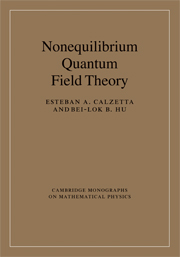Book contents
- Frontmatter
- Contents
- Preface
- I FUNDAMENTALS OF NONEQUILIBRIUM STATISTICAL MECHANICS
- II BASICS OF NONEQUILIBRIUM QUANTUM FIELD THEORY
- III GAUGE INVARIANCE, DISSIPATION, ENTROPY, NOISE AND DECOHERENCE
- 7 Closed time path effective action for gauge theories
- 8 Dissipation and noise in mean field dynamics
- 9 Entropy generation and decoherence of quantum fields
- IV THERMAL, KINETIC AND HYDRODYNAMIC REGIMES
- V APPLICATIONS TO SELECTED CURRENT RESEARCH
- References
- Index
8 - Dissipation and noise in mean field dynamics
from III - GAUGE INVARIANCE, DISSIPATION, ENTROPY, NOISE AND DECOHERENCE
- Frontmatter
- Contents
- Preface
- I FUNDAMENTALS OF NONEQUILIBRIUM STATISTICAL MECHANICS
- II BASICS OF NONEQUILIBRIUM QUANTUM FIELD THEORY
- III GAUGE INVARIANCE, DISSIPATION, ENTROPY, NOISE AND DECOHERENCE
- 7 Closed time path effective action for gauge theories
- 8 Dissipation and noise in mean field dynamics
- 9 Entropy generation and decoherence of quantum fields
- IV THERMAL, KINETIC AND HYDRODYNAMIC REGIMES
- V APPLICATIONS TO SELECTED CURRENT RESEARCH
- References
- Index
Summary
In Chapter 6 we presented the main computational schemes to derive the dynamical laws for the mean field, including the back-reaction from quantum fluctuations. These equations may be derived from the variation of the CTPEA. The result of this approach is a semiclassical theory of a c-number condensate interacting with a quantized fluctuation field.
This approach developed at this level of sophistication is limited as it offers no description of the fluctuations themselves. In most applications the magnitude of the fluctuations can be comparable and at times dominates the effects of the mean field in the semiclassical description. One possible way to incorporate fluctuations is to use the 2PI formalism, where the propagators describing the fluctuations are considered as dynamical variables evolving along with the mean fields.
In this chapter we shall explore a different strategy, which is to allow for a stochastic component in the mean field. This component arises from both the uncertainty of the initial configuration of the mean field, and from the fluctuations in the back-reaction from the quantized excitations. Both sources of randomness combine so that stochastic averages in the noisy theory reproduce suitable quantum averages in the underlying quantum field theory.
Formally, this approach lifts the seemingly overladen CTPEA. So far in this generally complex object, only the real part is enlisted in the derivation of the relevant equations of motion of the mean field.
- Type
- Chapter
- Information
- Nonequilibrium Quantum Field Theory , pp. 231 - 250Publisher: Cambridge University PressPrint publication year: 2008



